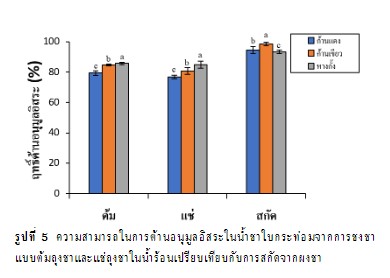Analysis of mitragynine and antioxidant content in kratom leaves tea
Keywords:
tea, kratom, mitragynine, antioxidantAbstract
Tea is a popular and important source of antioxidants, and kratom can be used to make tea. Different varieties of kratom leaves contain varying amounts of mitragynine, phenolic compounds, flavonoids, and other antioxidants. This study aimed to evaluate the mitragynine content, total phenolic content, flavonoid content, and antioxidant activity of kratom tea made from red vine, green vine, and serrate apex species. The dried, crushed kratom leaves were boiled and steeped for 5 and 10 min, and the results were compared to an extract obtained with methanol as a solvent. The results showed that the highest mitragynine content was found in tea made from the red vine, green vine, and serrate apex species, with levels of 5.98, 8.15, and 8.33 mg/g, respectively. The phenolic content was 368.60, 437.93, and 382.23 mg GAE/g, respectively. The flavonoid content was 210.88, 208.50, and 138.05 mg QE/g, respectively, and the antioxidant activity was 94.36%, 98.50%, and 93.23%, respectively. Processing kratom leaves into kratom tea results in a decrease in the amount of mitragynine, phenolic compounds, flavonoids, and antioxidant activity from the extract by about 80%, 90%, 75%, and 15%, respectively. The brewing method of boiling tea was a process that obtains a higher amount of active substances than steeping in hot water. Therefore, boiling is a suitable method for preparing kratom tea to obtain high antioxidant content.
References
Department of Agriculture. (2023). Kraom: market. Retrieved March 10, 2023, from https://www.doa.go.th/oard8/?page_id=4440
Godman, H. (2021). Can flavonoids help fend off forgetfulness?.RetrievedSeptember 17, 2021, from https://www.health.harvard.edu/blog/can-flavonoids-help-fend-off-forgetfulness-202109172596
Greger, M. (2014). How to Get Enough Antioxidants Each Day. Retrieved January 18, 2024, from https://nutritionfacts.org/blog/how-to-get-enough-antioxidants-each-day/
Hashish, A., Zein, H.,& El-Bhnsawy, R. M. (2018). Evaluation of total phenolic compounds, flavonoids and antioxidant activity of black and green tea drink among some available brands in the Egyptian market. Current Science International, 7(4), 721-730.
Hu, Z., Tang, X., Liu, J., Zhu, Z.,& Shao, S. (2016). Effect of parboiling on phytochemical content, antioxidant activity and physicochemical properties of germinated red rice. Journal of Food, 214, 285-292.
Inchuen, S., Pornchaloempong, P.,& Narkrugsa, W. (2010). Effect of drying methods on chemical composition, color and antioxidant properties of Thai red curry powder. Kasetsart Journal-Natural Science,44, 142-151.
Namchot, C., Phasuk, S.,& Takonphakdee. P.(2013). Efficiency of Feronia lomonia swingle branch crude extract asantioxidant.In the 5thRajamangala University of Technology National Conference, 28 March 2014, IMPACT Muang Thong Thani, Nonthaburi. (pp. 251-260). (in Thai)
Perry, M. (2018). What are polyphenols and how much you need.Retrieved July 30, 2018, from https://blog.zonediet.com/lifestyletips/what-are-polyphenols-and-how-much-you-need
Prathumthet, J., Taschanda, K., Tewasansern, C., Phuwanna, R.,& Drhuean, J. (2019). Evaluation of Antioxidant Property and Total Phenolic Content of Instant Flower Tea Powder from Curcuma sessilis Gage., Clitoria ternatea Linn. and Bombax anceps Pierre. KKU Science Journal, 47(3), 490-497. (in Thai)
Reilly, M.T., Norwood, V., Grabski, M.,et al. (2015). Ethnopharmacologic examination of Medicinal Mitragyna speciosa (kratom) in the United States. Drug and Alcohol Dependence, 152, 1-13.
Tanyaratsrisakul,A. (2012). Kratom and Health Care among Thais. Journal of Health Research and Innovation, 5(1), 1-9. (in Thai)
Trakulsrichai, S., Sathirakul, K., Auparakkitanon, J., Krongvorakul, J.,et al. (2015). Pharmacokinetics of mitragynine in man. Drug Design, Development and Therapy, 9, 2421-2429.
Von, G. A., Joubert, E.,& Hansmann, C. F. (1997). Comparison of the antioxidant activity of rooibos tea (Aspalathus linearis) with green, oolong and black tea. Food Chemistry, 60(1), 73 –77.
Wungsintaweekul,J., Choo-Malee, J.,Charoonratana, T.,& KeawpradubN. (2012).Methyl jasmonate and yeast extract stimulate mitragynine production in Mitragyna speciose. Biotechnology Letters, 34(10), 1945–1950.
Zailan, N. F. Z., Sarchio, S. N. E.,& Hassan, M. (2022). Evaluation of Phytochemical Composition, Antioxidant and anti-Diabetic Activities of Mitragyna speciosa Methanolic Extract (MSME). Malaysian Journal of Medicine and Health Sciences, 18, 92-99.
Nugraheni, Z. V., Gunawan, W. D., Laili, H. N., Putro, H. S., & Wahyudi, A. Analysis of antioxidant activity of black tea extract (Camellia sinensis L.) and the effect on organoleptic properties of cassava getuk. In AIP Conference Proceedings.https://doi.org/10.1063/5.0051534

Downloads
Published
Issue
Section
Categories
License
Copyright (c) 2024 Journal of Applied Science and Emerging Technology

This work is licensed under a Creative Commons Attribution-NonCommercial-NoDerivatives 4.0 International License.

